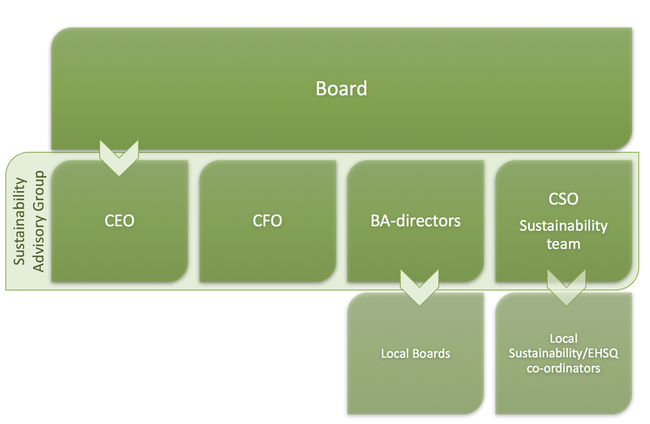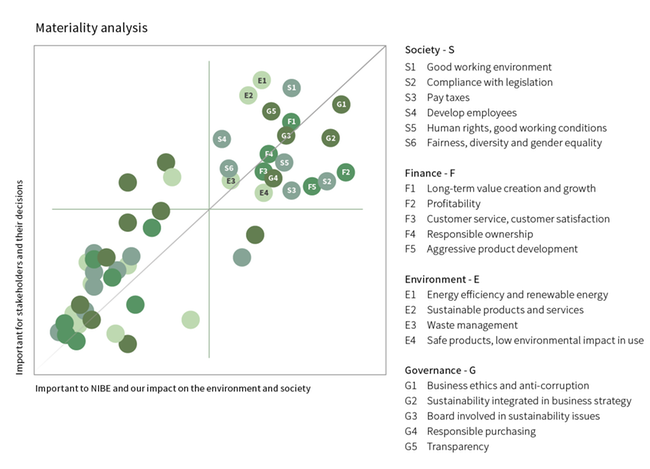GRI-Appendix
General Standard Disclosures
-
Organisational profile
Organisational profile
102-1 - Name of the orgaization
NIBE Industrier AB
102-2 - Activities, brands, products and services
The company manufacture products for indoor climate, heating, cooling and hot water. The company also produces applications for energy efficiency for both household and commercial use as well as components for infrastructure and wind energy. Business area Stoves produces wood and gas burning stoves and fireplaces, as well as electric fireplaces.
The Group does not manufacture products that are under ban in any countries or markets. There are however, different legal or customer driven requirements that needs to be followed for individual markets.A general discussion about particle emission and air quality in cities to some extent touch upon the use of wood burning stoves.
See www.nibe.com for more fully descriptions of brands, products and services.102-3 - Location of headquarters
NIBE is a Swedish company with its roots in the southern province of Småland and head office in Markaryd.
102-4 - Location of operations
NIBE is present in 21 countries in Europe, North America, Asia and Australia.
For detailed information about locations, see Annual report page 96-98.102-5 - Ownership and legal form
NIBE is listed on the NASDAQ OMX Stockholm Exchange, Large Cap list, with a secondary listing on the SIX Swiss Exchange.
NIBE’s 2017 Annual Report covers trademarks, ownership, changes in structure and size, geographical market presence, and a detailed account of financial results and key figures.102-6 - Markets served
NIBE is an international Group in heating technology and energy efficiency with sales in Europe, North America, Asia, Australia and other markets.
The Group consists of three business areas covering different product segments directed towards several industries:
1. NIBE Climate Solutions provides sustainable energy solutions for indoor comfort through a wide range of products for heating, cooling, ventilation, heat recovery and hot water heating for houses, apartment blocks and other large buildings, including commercial real estate.
2. NIBE Element provides components and solutions for measurement, control and heating designed for producers and users of industrial and consumer products.
3. NIBE Stoves offers stoves, fireplaces and chimney systems for different types of houses and commercial buildings.
End customers exist in a wide range from households to large building complexes, industries and manufacturers of for example cars or household appliances, construction companies and infrastructure applications.102-7 - Scale of the organization
During 2017 the average number of employees (headcount) was 14,300 (11,900) in 21 countries in Europe, North America, Asia and Australia.
Region
Number of employees (percentage)
Europe
56%
North America
37%
Asia and Australia
7%
Group sales in 2017 totaled 19,009 (15,348) million with an operating margin of 12,3 (12.9) percent. NIBE Climate Solutions accounted for 62 (62) percent of sales, NIBE Element 26 (27) percent and NIBE Stoves for the remaining 12 (11) percent.
This report includes 54 (44) production units and 28 (25) sales units see below table. Companies acquired during 2017 are not included. For details about assets, capitalization, shareholders and total number of operations, please see Annual report. Country
Company
Australia
Backer-Wilson Elements Pty Ltd
Fireplace Products Australia Pty Ltd
Hyper Engineering Pty Ltd
Austria
KNV Energietechnik GmbH
Schulthess Maschinen GmbH
Canada
FPI Fireplace Products International Ltd
China
Backer Heating Technologies (Shenzhen) Co. LTD
Backer-Springfield Dongguan Co. Ltd.
Lund & Sorensen Electric Heating Equipm. Accessory (Tianjin) Co. Ltd
Czech republic
Backer Elektro CZ a.s.
Backer Eltop s.r.o.
DZ Dražice - strojírna s.r.o.
Denmark
Danotherm Electric A/S
Eltwin A/S
JEVI A/S
KVM-Genvex A/S
Lotus Heating Systems A/S
Lund & Sörensen A/S
METRO Therm A/S
Motron A/S
SAN Electro Heat A/S
TermaTech A/S
Varde Ovne A/S
Völund Varmeteknik A/S
Finland
Kaukora Oy
Loval Oy
Meyer vastus AB, Oy
NIBE Energy Systems OY
France
Backer Calesco France Sarl
NIBE Energy Systems France SARL
NIBE Foyers France S.A.S.
Germany
ait-deutschland GmbH
Backer Wolff GmbH
NIBE Systemtechnik GmbH
Italy
ATE-Electronics S.r.l.
Backer Fer S.r.l.
Backer REBA Div. Resistors
Malaysia
Askoma SDN BHD
Mexico
Backer Alpe Monterrey
Backer Alpe Toluca
Backer EHP (Wiegand S.A. de C.V.)
Springfield Wire de Mexico SA de CV
Netherlands
NIBE Energietechniek B.V.
Sinus Jevi Electric Heating B.V.
Norway
ABK AS
Höiax AS
Nordpeis AS
Norske Backer AS
Poland
Backer OBR Sp z.o.o.
Eltwin Sp. z.o.o.
NIBE-Biawar Sp. z.o.o.
Northstar Poland Sp. z.o.o.
Termorad Sp. z.o.o.
Russia
Evan, JSC
Spain
Backer-Facsa, S.L.
Sweden
Air-Site AB
Backer BHV AB
Calesco
METRO Therm AB
NIBE AB
Switzerland
AIT Schweiz AG
Askoma AG
Backer ELC AG
Schulthess Maschinen AG
UK
Gazco Limited
Heatrod Elements Ltd
NIBE Energy Systems Ltd
Stovax Limited
USA
Backer EHP, Inc.
Backer Heating Technologies Inc.
Backer Hotwatt Inc
Backer Marathon Inc
ClimaCool Corp.
ClimateCraft Inc.
ClimateMaster Inc.
Enertech Global LLC
Fireplace products U.S. Inc.
Heatron Inc
International Environmental Corp.
KKT chillers, Inc.
Omni Control Technology Inc.
WaterFurnace International Inc
102-8 - Information on employees and other workes
The number of employees as full time equivalents (FTE) was in total 12 248 (13,100) by the end of 2017.
FTE
Permanently employed
Temporary employed
Region
Men
Women
Men
Women
Europe
3544
2079
265
166
North America
2810
1933
179
102
Asia
589
447
11
1
Australia
13
10
0
0
102-9 - Supply chain
The supply chain consists of approximately 6,000 (3,500) suppliers of direct material. The highest purchase volumes come from suppliers in Europe and North America. The product categories that represent most value are metals and electronics.
With many suppliers NIBE work closely and long-term, often developing components and parts for our products together. The procurement of direct material is to some extent centralized, and indirect material purchasing is made entirely locally.
Region
Purchased value per region, SEK
Europe
5 468 399 030
Asia and Oceania
1 327 825 032
Northern America
2 319 162 535
Latin America and the Caribbean
77 222 592 102-10 - Significant changes to the organization and its supply chain
In 2017 NIBE Group acquired 7 (10) companies, adding approximately SEK 1,7 billion or X percent to annual sales. These acquisitions affected the reporting of financial data for 2017, but will not affect the non-financial reporting until the first full year in the Group after acquisition.
These companies have been added since previous reporting period:
Air-Site AB
ATE-Electronics S.r.l.
Backer Hotwatt Inc
Climate Control Group
Fireplace Products Australia Pty Ltd
Fireplace Products U.S. Inc.
FPI Fireplace Products International Ltd
Heatron Inc
Omni Control Technology Inc
The manufacturing operation of Akvaterm in Finland was moved to the Kaukora plant. There are no other significant changes.
The number of reported Suppliers have changed due to revised reporting standard. NIBE now report suppliers in two categories: Direct and Indirect suppliers. Another reason for change is the number of new companies entering the Group during 2016.102-11 - Precautionary Principle or approach
NIBE applies a precautionary approach in connection to any changes in products or in the production processes. Before implementing changes, that could have negative environmental or safety impact, the management are required to carry out preventative risk assessments.
All production companies within NIBE Group, with more than 10 employees, are to be certified according to ISO 14001. Requirement for newly acquired companies are to be certified within two full years after acquisition. Systematic risk assessments and a precautionary approach is a mandatory part of ISO 14001.
102-12 - External initiatives
NIBE signed Global Compact in 2014 and committed in 2016 to six of the 17 sustainable development goals in Agenda 2030. NIBE also reports according to CDP and gives financial support to organizations like Hand-in-Hand and SOS Children's Villages.
The individual companies within NIBE Group are free to choose local initiatives to support, within the framework of our values and business principles.102-13 - Membership of associations
NIBE has actively chosen to participate in a number of industry organizations and standard organizations, on national, EU and international level. The objective is to advocate NIBE's interests, contribute with expertise and opinions as well as to keep informed of the current development. Each business area decides where to participate and to which extent based on the strategic needs for their industry and product categories. This means there is no such membership on Group level.
-
Strategy
Strategy and analysis
102-14 - Statement from senior decision maker
See Annual Report 2017 page 8-9, 40, 48, 56.
102-15 - Key impacts, risks and opportunities
See Annual Report 2017 page 45, 52, 59, 78-79.
-
Ethics and integrity
Ethics and Integrity
102-16 - Values, principles, standards and norms of behavior
NIBE has expressed the code of conduct in three folders titled Our Values, Our Business Principles and Our Working Methods. The NIBE Group management originally developed the content based on a long tradition of honest and upright business behavior. The content of the folders reflect the spirit of integrity that is the core of the NIBE culture and the ten principles of the Global Compact. The CEO has delegated the responsibility to update and publish the folders to the CSO. The Sustainability Council[1] approves changes in the content before release.
The folders are available in sixteen languages on our website and on the NIBE intranet. All companies receive the printed version in the local language. The content are to be part of the introduction.
When a new company enters the Group, the management is obliged to communicate and implement the Code of Conduct in the organization. All employees receive a printed copy in the local language. The Sustainability team evaluates the implementation in connection with regular company visits.
NIBE Code of Conduct is available for external parties and stakeholders on the website nibe.com. NIBE ask suppliers to sign a Supplier Code of Conduct, which is a summary of applicable principles in Our Values and Our Business Principles.102-17 - Mechanisms for advice and concerns abour ethics
Managers have the responsibility to seek advice on ethical and lawful behavior according to escalation procedures, when their knowledge or mandate is not sufficient. When especially delicate or difficult matters occur, access to expertise is granted through channels both within and outside the organization.
According to the Whistleblowing policy, all individuals within the organization have authorization to report any concern about unethical or unlawful behavior. The policy is available for download on our intranet. The policy contains a statement of non-retaliation.
Employees are primarily encouraged to report through the line management, but if that is not possible, they are informed how to use the whistleblowing function. The whistleblowing function is a shared external resource used by all companies within NIBE Group. It is available to all employees, who receive information how to use the function and is to be a part of the introduction. The function makes it possible to report anonymously from anywhere, at any time and in their own language. An external party handles all reports confidentially and according to best practice.
During 2017, we received two reports, which were referred to the Group’s department for whistleblowing in 2017.One was classed as an HR matter and managed according to the standard procedures.
The other matter was investigated and concluded within the whistleblowing system. -
Governance
Governance
102-18 - Governance structure
All operations follow national legislation, for example financial, environmental and labor legislation, where we are located. We are also under an obligation to comply with regional and international law, as well as voluntary undertakings such as the Global Compact.
NIBE’s Board of Directors bears the ultimate responsibility for ensuring that risks are managed and sustainability work meets the requirements of public authorities, shareholders and other company stakeholders.
The CEO reports to the Board of Directors.
The Group’s CSO reports to the Sustainability Council, with CEO as chairperson and CFO and the business area managers as members. The Sustainability Team is responsible for effectuating the strategic sustainability work and CEO reports on sustainability issues to the Boards of Directors at Group and business area levels.
The management of each company within the Group is responsible for local operational sustainability work and for compliance with Group guidelines. The managers of the individual company report to the business area manager.
The Sustainability team regularly visits the companies in the Group to monitor compliance with our Code of Conduct, common policies and guidelines.

-
Stakeholder Engagement
Stakeholder Engagement
102-40 - List of stakeholder groups
NIBE has included the following in the stakeholder groups whose opinions are of greatest importance to the Company and/or are affected most by the Company’s profit: shareholders, B2B customers in various sectors, end customers and installers, employees, suppliers, analysis institutes and other representatives of the financial sector and public authorities (supervisory and local).
102-41 - Collective bargaining agreements
Collective bargaining agreements cover 55 (49) percent of the employees.
102-42 - Identifying and selecting stakeholders
NIBE used an assessment method where we viewed each stakeholder group according to their power, legitimacy and urgency (Mitchel et al 1997). From the assessment, we could identify our key stakeholders, their presumed interests in the company, and a channel to engage with them.
102-43 - Approach to stakeholder engagement
Primarily the stakeholder's dialogue is the natural contacts with customers, employees and representatives for other groups.
Analysts, banks, funds, research institutes and universities often approach the company via interviews and questionnaires. NIBE has studied the subjects that are included in the questions they ask us, and included those in the list of material topics.
During 2016, NIBE carried out a structured dialogue with a selection from most stakeholder groups. Besides sending out a questionnaire to approximately 300 selected responders, we also made interviews and gathered data from written sources like analysts’ reports.
During 2017, NIBE collected and documented additional information in connection with naturally occurring contacts with different stakeholders. There are no visible changes regarding stakeholder views on the company.102-44 - Key topics and concerns raised
The top most important topics raised through our stakeholder engagement are:

-
Reporting practicies
Reporting practicies
102-45 - Operational structure of the organization
See Annual report page 96-98 or go to https://www.nibe.com/nibe-group.html External link. to see the list of companies included in the financial reporting.
Acquisitions made during 2017 are not included in the sustainability reporting.102-46 - Process for defining report content and Topic Boundaries and explain how the Reporting Principles have been implemented
Step 1: Identification
Relevant topics have been identified by looking at the different types of impact that occur in each step of our value chain. We have considered our products, market and supply chain, as well as our vision and mission in view of what needs be improved in order to support sustainable development. We have considered the impact outside the organization and in the interfaces between the organization and external parties, combined with what topics and concerns our stakeholders historically have raised. This gave us a gross list of possibly material topics that needed prioritization.
Step 2: PrioritizationWe used the list of identified topics as a basis for our stakeholder dialogue and for our internal discussions. All the topics were rated from the most important to the least important. From the list of rated topics, we have chosen to focus on the top 15-20 ones that have been considered as most important both by our external and by our group management team.
Step 3: ValidationWe have analyzed the outcome of step 1 and 2, and found that the prioritized topics represent a balanced combination that includes several angles of our economic, environmental and social responsbility. These topics might change over time, as our business develops and stakeholder demands changes.
102-47 - List of material topics
NIBE's working group for sustainability issues together with Group management carried out a materiality analysis based on the areas that are regarded as most relevant to the company's operational focus and geographical presence as well as international initiatives such as the Global Compact and Agenda 2030 (SDG). The assessment also included business environment requirements, global trends, standards (GRI, ISO 14001 and CDP), the Company’s expected future growth, with the concomitant risks and opportunities and the outcome of the dialogue with stakeholders. See Annual report page 34.102-48 - Restatements of information
No significant re-statements.
102-49 - Changes in reporting
Miscalculation in Energy efficiency value for 2016. Reported 10 actual value should be 11,2.
102-50 - Reporting period
Full year 2017
102-51 - Date of most recent report
April 2017
102-52 - Reporting cycle
Annually
102-53 - Contact point
102-54 - Claims of reporting in accordance with the GRI Standards
This report has been prepared in accordance with the GRI Standards: Core option
102-56 - External assurance
NIBE are currently not seeking external assurance for this report.
